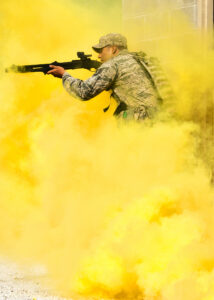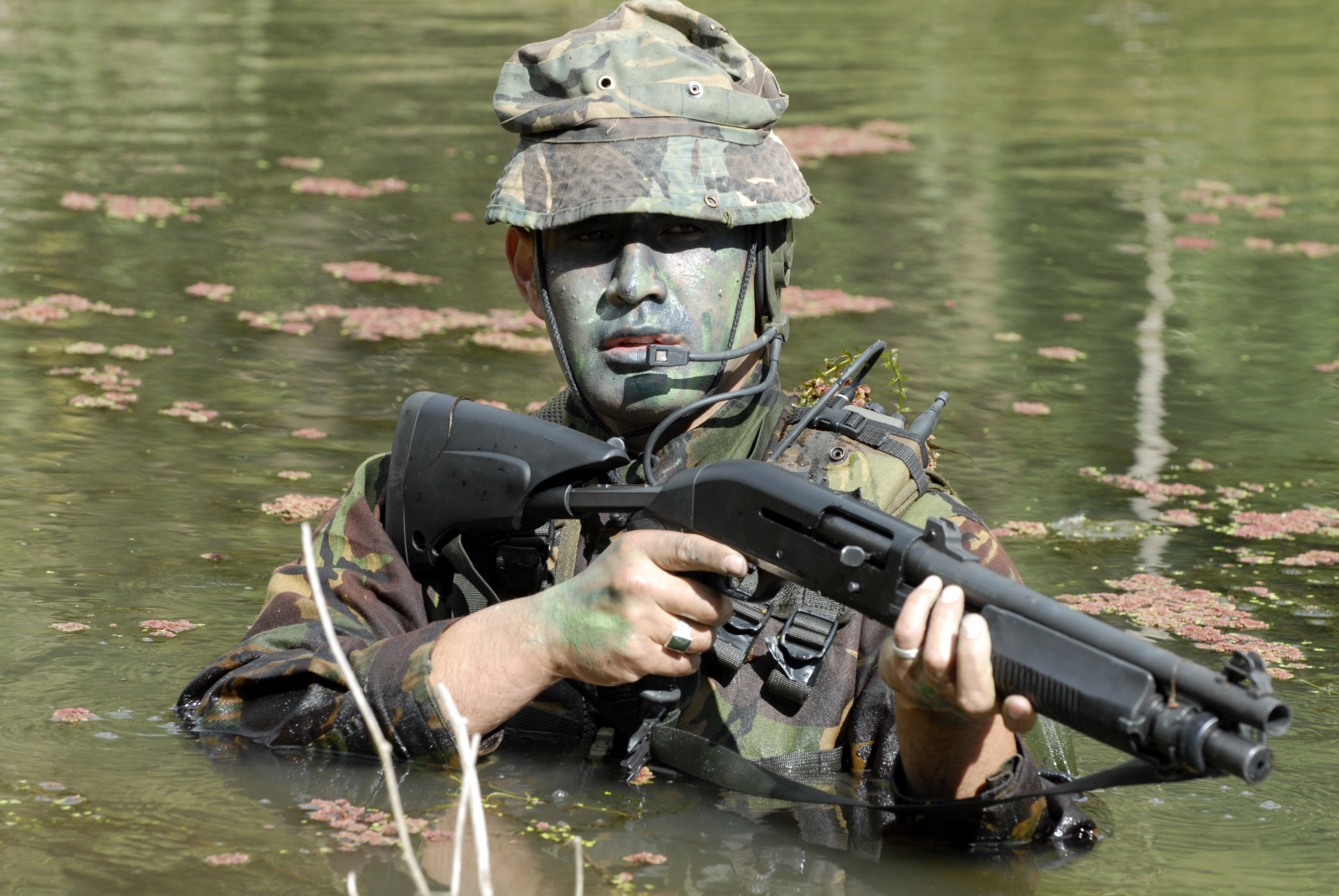While automatic rifles and machine guns form the backbone of modern infantry firepower, shotguns retain a niche role for combat operations. They also provide civilian police forces with a vital boost to their firepower without the need for escalation to automatic weapons, with the exception of special units and missions.
Like any weapon, shotguns possess certain strengths and weaknesses which dictate their optimal deployment. The primary strength is their very high stopping power or anti-materiel effect. The combination of large bore-size or gauge and the employment of either a single heavy projectile (slug) or numerous buckshot projectiles per round determines the above-average kinetic power of the combat shotgun. Military and police generally procure 12 gauge shotguns (with a bore diameter of 18.5 mm); standard ammunition is the 70-cm long 12/70 shell.
The weapon’s primary limitation is range. Given the lack of barrel rifling in most (but not all) shotguns, and the natural tendency of buckshot to spread out, shotguns have a significantly lower effective range than rifles. The combination of pellet spread and waning velocity will limit a 12 gauge weapon firing 00 buckshot to an effective range of about 30 m. A slug, especially when fired from a shotgun with a rifled barrel, can engage targets up to approximately 100 m, still well below a carbine’s range.
These characteristics make the shotgun most suitable for military and police close-quarters scenarios in both urban and field settings. This includes house-to-house search and clearing missions, trench clearing, maritime boarding (and counter-boarding) operations, or point defence. Shotguns have also been extensively employed for jungle warfare. The ammunition’s tendency to spread, and the shotgun’s ability to deploy less-than-lethal munitions, also make the weapon suitable for riot control or similar scenarios.

Credit: USAF
Shotgun Ammunition
The wide variety of available munitions adds to the shotgun’s versatility. For close-range anti-personnel engagements, 12/70 shells loaded with 00 buckshot provide optimal stopping power at short range. A single 00 buckshot ball projectile has approximately the diameter of a .32 calibre bullet. The individual buckshot ball is somewhat lighter than the bullet, but a typical 12/70 gauge shell will be packed with between eight and 12 balls of lead or steel shot, fired at a muzzle velocity of 1,300 feet per second; larger 12/76 Magnum shells hold up to 15 balls. At typical engagement range, multiple balls will strike a person-sized target simultaneously, inflicting heavy damage to unarmoured personnel. A joint service study carried out in the 1990s by the US Armed Forces, (which incorporated the experience of British forces during Operation Claret in Borneo in the 1960s), determined that the likelihood of hitting person-sized targets with a shotgun was considerably higher than with any other firearm type, and twice as high as the odds of hitting an enemy with an assault rifle burst.
Shotgun slugs are aerodynamically more stable than balls. This is especially true for rifled slugs which are endowed with ribbing, inducing spin while the projectile is fired through a smooth barrel, and for saboted slugs, which are fired from rifled barrels. Full-bore lead or copper slugs’ typical weight range runs between approximately 25 to 32 g (383-492 grains), approximately three times as much as a NATO 7.62 × 51 mm rifle round. Slugs can also be used in situations where the spread of shot entails too much risk of collateral casualties. Their mass and velocity also make them suitable for attacking armoured adversaries and in the anti-materiel role, including penetration of vehicle engine blocks.
A major use for police and military shotguns is fast forcible entry into rooms or buildings. Breaching rounds are specialised slugs designed to forcibly open doors with minimal risk to humans. These frangible rounds are composed of loose materials such as metal powder tightly packed into a wax casing. They can be fired at hinges or locks (including padlocks) on doors and gates, at steel bars securing windows, or at plate glass windows. The frangible slug disperses into its components immediately after impact to prevent ricochet and injury to either the breaching team or non-combatants inside the room. Other non-lethal munitions (or munitions with a significantly reduced risk of death) include rubber slugs, rubber buckshot, beanbag rounds and teargas rounds.
Pump-Action
Military and police shotguns normally fall within one of two categories: pump-action guns or semi-automatic shotguns. The pump-action gun represents older technology and has a somewhat slower rate of fire. On the other hand, the mechanism is less complex and therefore less prone to jam or foul. Both categories are equipped with gun safeties to prevent accidental discharge. Pump-action shotguns frequently feature a ventilated hand guard on the barrel to avoid burns to the user’s support hand.
The Mossberg 500 series, produced by O.F. Mossberg and Sons, remains very popular with police and military forces around the world. The most popular iteration is the Model 590. It was designed for combat operations, and is the only shotgun to meet the US Army’s MIL-S-3443E specification defining standards for accuracy, endurance and ruggedness. It features a heavy-walled barrel, a clean-out magazine tube, a top-mounted ambidextrous safety, and an anti-jam elevator. The weapon can be customised with various stocks, a pistol grip, optional ghost ring or reflex sights, and front-end configurations including a bayonet lug.
The shotgun comes with either a 47 cm or a 51 cm barrel. The tubular magazine’s capacity ranges from six rounds for the shorter barrel, to eight or nine for the longer configuration. In 2018, Mossberg introduced the 590M variant which accommodates detachable magazines with 5, 10, 15 or 20-round capacity. The larger capacity, plus ease of reloading, provides a considerable advantage over most shotguns during intense firefights. Mossberg 500 series shotguns are in service with the police and military of more than 20 nations.
The Remington Arms Company has designed 16 variants of its 870 series pump-action shotgun. Four of these are specifically targeted to police and military users. The Model 870 is known as an extremely robust gun with smooth cycling. Depending on configuration, barrel length ranges from 28 to 76 cm. Shorter barrels are preferable for police and breaching operations, while longer barrels provide enhanced accuracy and effective range for combat.

Credit: US DoD
The 870 MCS (Modular Combat Shotgun) variant was introduced in 2004. The core of the MCS is formed by the common receiver consisting of the trigger group, bolt, pump-action, a three-round magazine tube, and a Picatinny rail for mounting a selection of optics including laser sights. The receiver is customised with additional components according to mission requirements, and can be reconfigured at any time. Three stock/grip options are available, including a pistol grip with fixed stock, a grip with collapsible stock, or a pistol-grip-only configuration. Barrels are available in 25, 35.5, and 46 cm lengths. The short barrel paired with only the pistol grip is known as the Breacher configuration, and can be carried in a holster. The longer barrels can accommodate various sight options, a flash suppressor, and magazine extensions increasing internal capacity up to six rounds. The various iterations of the Remington 870 serve worldwide with police and armed forces of 30 nations.
Semi-Automatic
Beretta produces the 1301 family of semi-automatic shotguns specifically for the law enforcement and home defence market. The latest iteration is the 1310 tactical which features enlarged, shooter-friendly safety and bolt-release buttons and charging handle, and an oversized loading port. According to Beretta, the firm’s proprietary BLINK gas operating system, coupled with a cross-tube gas piston, cycles rounds 36% faster than competing firearms. The back-bored barrel is designed to dissipate recoil and reduce muzzle flip. The adjustable stock and optional pistol grip, interchangeable front sights, and a Picatinny rail allow for significant customisation by the operator.
Italy’s Benelli Armi SpA (a subsidiary of Beretta) produces two popular semi-automatic shotguns. The M2 Tactical comes with a five-round internal magazine, a standard 47 cm barrel, a pistol grip for greater control, and a selection of sights including specialised optics attached to an optional Picatinny rail. Benelli claims that the M2 has up to 48% less recoil than competing weapons, enhancing both comfort and accuracy. The firm also produces the M1014 or M4 semi-automatic shotgun. It was designed in the 1990s to meet specific requirements of the US Marine Corps (USMC), but has since entered service with numerous armed forces including the Italian Army. It can be modified with various sight optics and other attachments.
The particular advantage of semi-automatic shotguns’ enhanced rate of fire was illustrated by a British Special Air Service (SAS) member in Iraq. As reported in 2019, the soldier breached an ISIS bomb factory, and was immediately confronted by five hostiles, two of whom wore suicide vests. With his M1014, he killed all five within seven seconds, effectively decapitating the two suicide bombers and saving the lives of his entire team.
Hybrid Shotguns
One notable disadvantage of semi-automatic shotguns’ gas-operated cycling system is reduced reliability when firing lower-powered loads including non-lethal munitions and breaching rounds. Hybrid shotguns such as the Benelli M3 and the Franchi SPAS family of weapons allow the user to switch between modes depending on the munition load and the operational scenario.

Credit: New Zealand Defence Force
The Benelli M3 is offered in several variants including the standard M3 Super 90. Switching firing modes is accomplished within a second by turning the selector lever. The Super 90 is available with a fixed or a collapsible stock and an optional pistol grip. The optional Benelli Super Nova Tactical Collapsible Stock can be locked into five different positions allowing the user to optimise the seat of the weapon to accommodate body armour. The weapon has an overall length of 104 cm. The more compact M3T variant is similar to the Super 90, but comes standard with a pistol grip and tubular metal folding stock. Both variants’ tubular magazine fits seven 12/70 rounds. The most compact variant is the M3T Short, with an overall length of 63.5 cm (with folded stock) and a five-round magazine. The M3 family is used primarily by military and police special operations units in 14 nations, mostly in Europe and Asia.
The SPAS-15 and its predecessor the SPAS-12, both produced by Luigi Franchi SpA., stand out visually. The SPAS-12, developed in the 1970s specifically for military applications, is an extremely rugged weapon available with four different barrel lengths ranging from 46 to 61 cm. The shorter barrel version was a later design optimised for law enforcement use. Internal magazine capacity ranges from five to eight rounds, with longer barrel variants being able to accommodate larger tubular magazines. Both fixed and folding-stock versions are available. An interesting enhancement is the optional hook-shaped folding stock. It can be rotated 90 degrees to fit under the shooter’s forearm, permitting stable one-handed operation in semi-auto mode. Primary users are currently police and special operations units. The SPAS-15’s form, featuring a Picatinny rail, pistol grip, box magazine (three or six rounds), and tapered barrel resembles an assault rifle. It is used by the Italian Army and Carabinieri, and by various police and military special operations units globally.
Full-Automatic Fire
A small number of fully-automatic shotguns have been developed over the decades, but most programmes were terminated due to an overall lack of interest by armed forces. The AA-12 Atchisson Assault shotgun, originally developed by Maxwell Atchisson in 1972 and sold to Military Police Systems Inc. (MPS) in 1987, boasts a theoretical 300 rounds-per-minute firing rate. According to the manufacturer, 80% of recoil is absorbed by the proprietary gas system, making it possible to remain trained on target while firing in full auto mode. The AA-12 was tested by multiple services, including the USMC, but was never acquired by any force. Korea’s SNT Motiv Co., Ltd. (Formerly Daewoo Precision Industries) currently markets the automatic USAS-12 (Universal Sporting Automatic Shotgun 12 gauge) which is derived from the original AA-12. The USAS-12 comes in a semi-automatic variant for the civilian market, and a military/police variant which can be set for full- or semi-automatic fire. The gas-operated weapon has a 400 rounds-per-minute rate of fire, and an effective range of 40 m. Magazine options include a 10-round box and a 20-round drum; fully loaded, the weapon weighs in at 6.8 kg. The automatic variant is operated by various military and police special operations units in Asia and Latin America.

Credit: USMC
New Configurations and New Missions
In 2012, following years of operational testing in Iraq and Afghanistan, the US Army commenced serial fielding of the M26 Modular Accessory Shotgun System (MASS). It is designed as an add-on to be mounted below the barrel of a standard M4 or M16 assault rifle, providing the soldier two weapon options in one unit and obviating the need to carry two separate firearms. Alternately, MASS can be equipped with a stock and be deployed as a stand-alone weapon. Either way, MASS is lighter than the Mossberg 590; depending on configuration, the unit weighs up to 2.25 kg and has a 19-cm barrel. It fires 12/70 shells and can accept a three or five-round box magazine. The US Army currently has 9,000 units in its inventory, with most weapons issued to specialised units such as the military police and engineers. In the long run, it is expected to completely replace the Mossberg in the US Army inventory.

Credit: US Army
Looking forward, Counter-Unmanned Aerial Vehicle (C-UAV) is becoming something of a new mission for combat shotguns. Quadcopters and other tactical UAVs deployed either as reconnaissance and targeting systems, or as armed assault drones, have become an increasing menace for frontline troops. Buckshot’s natural spread makes shotguns especially suited for targeting small to medium UAVs, which approach within effective range, while well-aimed slugs can disable heavier UAVs at even greater distances. Special munitions, including shells that deploy nets to ensnare UAVs or that release viscous substances designed to immobilise rotors, are also being developed. All other applications aside, the UAS threat will ensure that the venerable shotgun, which has been systematically used by the military since the American Civil War, will remain relevant well into the 21st century.
Sidney E. Dean



